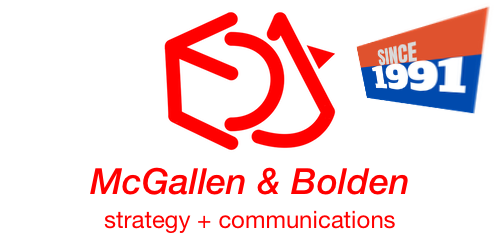The AI wave is already causing a rift between those who bravely adopt it, and those who shy away from it. However, AI is an unstoppable eventuality of humanity, and science fiction in all manners of novels to movies have illustrated scenarios in multi-faceted outcomes. To truly harness the abilities of AI, just as we did in the 1990s with the Internet and the 2000s with social media, we have to dive right in and use it. We at McGallen & Bolden have always done that, adopting technology head on, understanding it and then harnessing it to our advantage. And we have, with AI as well.
AI is but a tool, and those of us who manage and harness tools to our advantage, will thrive. We cannot allow mere tools to be our masters, because we are to be masters of tools, to be the artisans picking up hammers and chisels to sculpt art and machinery. So, what do we as a strategy and communications firm do with tools like AI?
Technology as an enabler is not new to us. McGallen & Bolden Group has been at the forefront of harnessing technologies as tools to better our work for ourselves and clients.
We are techies first
In the 1990s before the Internet arrived, we were the first boutique consulting firm to leverage on proprietary email (CompuServe, now owned by Yahoo), in-house bulletin board severs (BBS, the precursor to modern social networks), CRM (customer relationship management for media management), and digital fax (to disseminate news materials). We were also the first public relations (PR) agency in our side of the world to use Digital PR, creating digital press kits with interactive presentations authored on proprietary authoring tools, delivered on 3.5-inch floppy disks, and given to journalists.
In 1996, when commercial Internet arrived, we went beyond email. We started researching UNIX and UNIX-like servers, developing sophisticated websites for government agencies and multinational clients, and hosted them ourselves with backend management.
And in 2000, we brought in our own AVID non-linear video editing suite, producing cinematic advertisements and news materials for our clients.
By 2002, we were also the first boutique consulting firm in our locale to develop our own networked knowledge management systems (KMS), housing our consulting content and templates for ISO 9000, ISO 14000, total quality management (TQM), service quality, and public relations. The KMS was running on a local area network (LAN) for our team, and was also usable across the Internet.
A year later in 2003, we took our UNIX and cybersecurity knowledge further, culminating in a BSD Unix based email security server appliance NetJanus™, that provided malware filtering for standard email services. The appliance was a mini-ITX server, and could also run off a Mac running UNIX.
Between 2010 to 2011, we migrated our web development from HTML hand-coding to content management systems (CMS), adding mobile app development on multiple platforms.
All these while, we provided our mainline consulting for clients in public relations, marketing, communication (internal and external stakeholders), branding, and business strategy. Technology was an enabler from our humble beginnings in the 1990s right to today to propel and accelerate our mainline consulting work.
The AI inflection
From early 2020, the world became locked down by the global pandemic, that disabled and even shuttered many businesses, decimating jobs worldwide, and gave the world the worst disaster that confounded governments to their knees. It was in those times we kept on fighting, continuing to optimize and use technologies to further our work, laboring away for our clients, and helping them sustain and grow through the global crisis.
2022 was the year that AI became a conversational topic. Rather than shy away from a new unknown to many, we confronted it head on, just as we did from the 1990s with all manners of electronic mail, content delivery, video creation, the Internet, social networks, and cybersecurity.
Our team quickly started to research the various tools available, and how best each of these tools could be used. We tested many of the similar tools out there, investing in time and financial resources to best understand what could work, what would work for us, and what would not be suitable for us and our clients.
While we have used all manners of AI for content creation from text, audio, voice, to video, the most fascinating AI has to be LLMs (large language models) including those making headlines in early 2023 such as OpenAI’s ChatGPT.
However, we knew the AI world is not just about OpenAI, but much more. There are a variety of open source and publicly available LLMs, as well as many ways to use them, even offline (fencing them within our own computers rather than running on the cloud). We also studied ways to write prompts, known as “prompt engineering”, so that just as we have been good at running web searches on the Internet making smart queries, we can make common AI LLMs which can make silly “hallucinations”, provide better and truer answers to our needs.
Turning AI into our internal knowledge resource
But making AI chatbots is not all there is. We have consolidated some of our legacy consulting materials as well as other public materials, to train the AI with our own knowledge and materials, essentially turning our old knowledge management systems (KMS) into conversational virtual “colleagues” that our team can leverage on. Our team can just ask some questions and get some answers, and these answers can be structured and refined, which makes it much better than the old KMS we had.
The journey certainly does not stop here. Our clients should be able to tap on some of these resources eventually, when we have segregated and refined client-specific materials from our internal knowledge resources, with parallel tracks to a centrally managed AI-powered KMS. This goal is not even that far away, so stay tuned.
If you want to engage us for public relations, crisis communication, media training, business strategy, and branding, talk to us today.
Watch the YouTube version here:
###

Dr Seamus Phan – Global C-suite Publicist & Strategist (Biochemist, Cybersecurity & Webdev pioneer, Author, Journalist) with 37 years of professional field experience.




